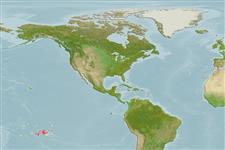Classificatie / Names
Lokale namen | Synoniemen | Catalog of Fishes(Genus, Soort(en)) | ITIS | CoL | WoRMS | Cloffa
>
Pleuronectiformes (Flatfishes) >
Soleidae (Soles)
Etymology: Aseraggodes: Greek, aggos, -eos, -ous = vessel, uterus, carapace of a crab + Greek, aseros, -a, -on = to remove the appetite (Ref. 45335); auroculus: Name from the Latin 'aurum' for gold and 'oculus' for eye, referring to the bright golden color of the eyes.
More on author: Randall.
Environment: milieu / climate zone / depth range / distribution range
Ecologie
marien rifbewoner; diepte 15 - 24 m (Ref. 57560). Tropical
Eastern Central Pacific: Society Islands.
Grootte / Gewicht / Leeftijd
Maturity: Lm ? range ? - ? cm
Max length : 3.6 cm SL mannelijk / geslacht onbekend; (Ref. 57560)
Korte beschrijving
Determinatiesleutels | Morfologie | Morfometrie
Dorsale zachte stralen (totaal) : 74 - 77; Anale zachte stralen: 56 - 57; Wervels: 37 - 38. Diagnosis: Dorsal rays 74-77; anal rays 56-57; most dorsal and anal rays double branched. Lateral-line scales 69-73. including 6-7 anterior to a vertical at upper end of gill opening. Vertebrae 37-38; dorsal pterygiophores anterior to fourth neural spine 12. Body depth 2.45-2.6 in SL; head length (HL) 3.85-3.95 in SL; eye diameter 4.55-4.9 in HL; upper eye overlapping a anterior two-thirds to three-fourths of lower eye; interorbital space narrow, the vertical distance between eyes about one-fourth to one-sixth eye diameter. Caudal peduncle absent. Short fleshy cirri on ventral edge of head. Lateral line aligned with ventral part of upper eye. Longest dorsal ray 1.55-1.7 in HL; caudal fin rounded, 4.4-4.55 in SL in length; pelvic fins 2.4-2.7 in HL, the tip of longest ray reaching base of second or third anal ray. Body color of ocular side in alcohol pale yellowish brown with 3 rows of large irregular blackish blotches, one dorsal, one ventral, and one midlateral; a few small dark spots on fin rays; blind side pale yellowish, the dark spots on rays faint (Ref. 57560).
Collected from steep sloping bottoms dominated by coral rubble (Ref. 57560).
Levenscyclus en paargedrag
Maturiteit | Voortplanting | Paaien | Eieren | Fecunditeit | Larven
Randall, J.E., 2005. A review of soles of the genus Aseraggodes from the South Pacific, with descriptions of seven new species and a diagnosis of Synclidopus. Memoirs of Museum Victoria 62(2):191-212. (Ref. 57560)
Status op de Rode Lijst van het IUCN (Ref. 130435: Version 2024-1)
Gevaar voor de mens
Harmless
Gebruik door de mens
Tools
Speciale rapporten
Download XML
Internetbronnen
Estimates based on models
Preferred temperature (Ref.
123201): 26.9 - 29, mean 27.8 °C (based on 99 cells).
Fylogenetische diversiteitsindex (Ref.
82804): PD
50 = 0.5000 [Uniqueness, from 0.5 = low to 2.0 = high].
Bayesian length-weight: a=0.00977 (0.00466 - 0.02049), b=3.07 (2.90 - 3.24), in cm total length, based on LWR estimates for this (Sub)family-body shape (Ref.
93245).
Trofisch niveau (Ref.
69278): 3.2 ±0.5 se; based on size and trophs of closest relatives
Weerstandsvermogen (Ref.
120179): Hoog, minimale populatieverdubbelingstijd minder dan 15 maanden (Preliminary K or Fecundity.).
Fishing Vulnerability (Ref.
59153): Low vulnerability (10 of 100).
